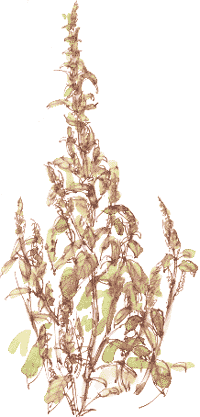| Sea
Kale Beet
Wednesday, 17th September 2003
Richard Bell's Wild West Yorkshire nature diary

 Previous Page | This Month | Home
Page | Next Page
Previous Page | This Month | Home
Page | Next Page 

 This
6 foot tall plant of Swiss Chard, beta vulgaris,
also known as 'Sea Kale Beet', has grown up on the furthest veg
bed, the one that never got fully dealt with this year. This
6 foot tall plant of Swiss Chard, beta vulgaris,
also known as 'Sea Kale Beet', has grown up on the furthest veg
bed, the one that never got fully dealt with this year.
 It
has clusters of greenish flowers that look like little bottle-brushes. It
has clusters of greenish flowers that look like little bottle-brushes.
 Though
the flowerheads are softly bristly to the touch the simple leaves
and the crimson-washed stems are smooth and polygonal in cross-section,
like a pencil. There are no ribs on the stem. Though
the flowerheads are softly bristly to the touch the simple leaves
and the crimson-washed stems are smooth and polygonal in cross-section,
like a pencil. There are no ribs on the stem.
 Swiss
Chard is a cultivated variety of Sea Beet, Beta
vulgaris, a coastal species that, in its other cultivated varieties,
is grown as spinach beet and beetroot. Swiss
Chard is a cultivated variety of Sea Beet, Beta
vulgaris, a coastal species that, in its other cultivated varieties,
is grown as spinach beet and beetroot.

Swiss Chard, Beta vulgaris cycla

richard@willowisland.co.uk

 Previous Page | This Month | This
day in 2001 | Home Page | Next
Page
Previous Page | This Month | This
day in 2001 | Home Page | Next
Page 

|